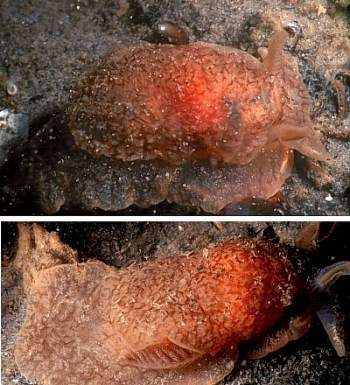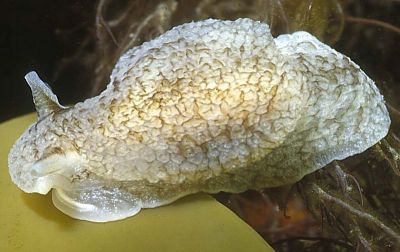
Pleurobranchaea obesa?
(Verrill, 1882)
Order: NOTASPIDEA
Superfamily: PLEUROBRANCHOIDEA
Family: Pleurobranchidae
DISTRIBUTION
East coast of North America?
PHOTO
off Long Island, New York, USA. May 1998. PHOTO: Betsey Hansen.
RELATED TOPIC
The Pleurobranchaea on this page may be P. obesa, but it may also be P. tarda Verrill, 1880, which is known from shallower waters from Cape Cod and to the south. It also is known from South African waters. It would be difficult to verify the identification without examining the reproductive anatomy. The penial morphology is quite distinctive between P. obesa and P. tarda.
Reference:
• Marcus, E. & Gosliner, T.M. (1984) Review of the family Pleurobranchaeidae (Mollusca, Opisthobranchia). Annals of the South African Museum, 93(1): 1-52.
See Betsey Hansen's message below.
See Terry Gosliner's message below.
Rudman, W.B., 1999 (July 29) Pleurobranchaea obesa? (Verrill, 1882). [In] Sea Slug Forum. Australian Museum, Sydney. Available from http://www.seaslugforum.net/find/pleuobes
Related messages
Pleurobranchaea from Rhode Island, USA
June 8, 2001
From: Paul Young

We came across this critter diving off Jamestown, Rhode Island, USA on May 11, 2001. We were in 10 meters of water. The animal is about 3 cm long.
It doesn't appear in any of my books. Can someone identify it?
Paul Young
young@underwater.org


Dear Paul,
This is a species of Pleurobranchaea,
possibly P. tarda Verrill, 1880 which is known from the West Atlantic from Martha's Vineyard to south of Cuba, East Atlantic from Ghana & Cape of Good Hope, Sth Africa. Intertidal to 1450 meters.
Unfortunately there appears to be no good distinguishing external features separating it from P. obesa which also occurs in the east coast of North America. Marcus & Gosliner (1984) say the mantle edge 'often forms an exhalant siphon over the anal opening and the tip of the gill. Their accompanying photo (Fig 4) has apparently been reversed in the printing process with the gill and siphon appearing on the left side. Your photos show this very feature, but whether it is really species specific or just a feature of the genus I couldn't say.
The best I can say is that it is a species of Pleurobranchaea. Any more would require the animal to be dissected. They are a fairly advanced group of pleurobranchs and if you have a look at the other messages on this page and use the Species List to look at the other species of the genus on the Forum you will find quite a bit of biological information. I have included enlargements of the gill tip and the right rhinophore to show their structure.
Marcus, E. & Gosliner, T.M. (1984) Review of the family Pleurobranchaeidae (Mollusca, Opisthobranchia). Annals of the South African Museum, 93(1): 1-52.
Apart from the sterling efforts of Betsey Hansen we have very few photos of sea slugs from the temperate waters of the east coast of the USA. If you have others you are willing to share with us they would be very welcome.
Best wishes,
Bill Rudman
Thanks
August 7, 1999
From: Betsey Hansen
Bill,
I saw the new page on your web site the next day. It looks great. Thanks for your help and all the information. I am sending you some new slides today under separate E-Mails. Don't worry about how long the identifications take. This is just a hobby for me. I appreciate whatever information you can provide. I've bought every book on Sea Slugs I could find and was thrilled to find all the slug sites on the internet. Unfortunately, there is very little on sea slugs in my area.
Best Regards,
Betsey
Elizabeth.P.Hansen@chase.com
Hamsen, E.P., 1999 (Aug 7) Thanks. [Message in] Sea Slug Forum. Australian Museum, Sydney. Available from http://www.seaslugforum.net/find/1154Dear Betsey,
Glad to be of help. Information and photos of living opisthobranchs from the western Atlantic is very difficult to obtain. The late Kerry Clark's West Atlantic Opisthobranch website, is one of the few places to get easy information on the opisthobranch fauna of that region.
Photos of any sea slugs from your region, and questions would be welcome. Although I have no personal experience of your fauna, as you have seen, there are many opisthobranch workers accessing this site and helping out with identifications and information, when needed.
Best wishes,
Bill Rudman.
Re: Pleurobranchaea from New York
July 31, 1999
From: Terry Gosliner
Dear Bill,
It is great to see some opisthobranchs from the Atlantic coast of the U.S. Some of these are old friends from my days of working in New Hampshire on my Ph.D with Larry Harris, Alan Kuzirian, Trish Morse and many others. Betsey Hansen's Pleurobranchaea may be P. obesa, but it may also be P. tarda, which is known from shallower waters from Cape Cod and to the south. It also is known from South African waters. It would be difficult to verify the identification without examining the reproductive anatomy. The penial morphology is quite distinctive between P. obesa and P. tarda.
All the best,
Terry
tgosline@calacademy.org
Gosliner, T.M., 1999 (Jul 31) Re: Pleurobranchaea from New York. [Message in] Sea Slug Forum. Australian Museum, Sydney. Available from http://www.seaslugforum.net/find/1140Pleurobranchaea from New York
July 29, 1999
From: Betsey Hansen


Bill,
Here is a Nudibranch that I can't identify. These slides were also taken in the Northwestern Atlantic off Long Island New York. I have only seen this nudibranch twice. Both times were last summer. The first time was in May (spring). I found three different ones, two of which were crawling around on mussel beds and the third was hidden behind a piece of seaweed.
Unfortunately, I didn't have my camera with me at the time. The second sighting was late last summer (September). I only found one at that time, but took several pictures. One shot shows what I believe to be this Nudibranch's eggs.
When I tried to move the Nudibranch to get a better look at it, it swam back to the rocks where it was hiding. It was amazing. I have not found this Nudibranch this year nor have I found it's eggs. I have searched through the entire slug site, but I cannot find anything close to it. Please let me know
what you think.
Best Regards,
Betsey
Elizabeth.P.Hansen@chase.com
Hansen, E.P., 1999 (Jul 29) Pleurobranchaea from New York. [Message in] Sea Slug Forum. Australian Museum, Sydney. Available from http://www.seaslugforum.net/find/1129Dear Betsey,
Sorry you had to search the whole site and still have no luck. I have just prepared a page on an Australian and New Zealand species Pleurobranchaea maculata. Have a look there for a bit of background on a related species.
Your animal is a species of Pleurobranchaea, probably Pleurobranchaea obesa Verrill, 1882, but species in this genus are difficult to determine from external features. Hopefully someone from your part of the world wil recognise the animal from your photos and correct or confirm my identification.
The egg ribbon in which you can see the spiral coil of little white eggs is interesting because species of Pleurobranchaea seem to have one of two different shaped egg masses. Pleurobranchaea bubala from southern Africa (Marcus & Gosliner, 1984) and Pleurobranchaea japonica from Japan (Tsubokawa & Okutani, 1991) have a cylindrical egg ribbon similar to your photo, while P. californica has a flattened dorid-like ribbon which is attached along one edge in a sinuous band (Chivers, 1967).
Species of Pleurobranchaea belong to a group of Sea Slugs (Order Notaspidea) which are sometimes called the side-gilled slugs because they have a large gill on the right side of the body beneath the mantle skirt. Good pictures of the gill are found on the Pleurobranchus forskalii page. Some side-gilled slugs can swim when disturbed. As you obviously witnessed, it is a spectacular sight. One other point is that these slugs are not nudibranchs. They are Opisthobranch Sea Slugs but the Order Nudibranchia are a separate evolutionary line of Sea Slugs. If you are confused, or interested, the page with the Species List is arranged to show the relationships between the different groups of Sea Slugs. The aim, if I get time, is to prepare some general pages on the orders and families so that newcomers to th world of Sea Slugs do not just drown in a sea of scientific names.
Best wishes,
Bill Rudman.
References:
* Cattaneo-Vietti,R; Burlando,B; Senes,L (1993): Life history and diet of Pleurobranchaea meckelii (Opisthobranchia: Notaspidea). J. Moll. Stud. 59, 309-313.
* Chiver, D.D. Observations on Pleurobranchaea californica MacFarland, 1966 (Opisthobranchia, Notaspidea). Proceedings of the California Academy of Scineces, 32(7): 515-521.
* Gosliner,TM (1985): Redescription and systematic position of Pleurobranchaea obesa (Verrill, 1882) (Opisthobranchia: Pleurobranchaeidae). The Veliger 28(1, 1 July), 109-114.
* Marcus, E. & Gosliner, T.M. (1984) Review of the family Pleurobranchaeidae (Mollusca, Opisthobranchia). Annals of the South African Museum, 93(1): 1-52.
* Tsubokawa,R; Willan,RC; Okutani,T (1992): Taxonomy of the two species of Pleurobranchaea in Japan (Gastropoda: Notaspidea: Pleurobranchidae). Venus, The Japanese Journal of Malacology 50(4), 249-263.
Bill Rudman.
Rudman, W.B., 1999 (Jul 29). Comment on Pleurobranchaea from New York by Betsey Hansen. [Message in] Sea Slug Forum. Australian Museum, Sydney. Available from http://www.seaslugforum.net/find/1129